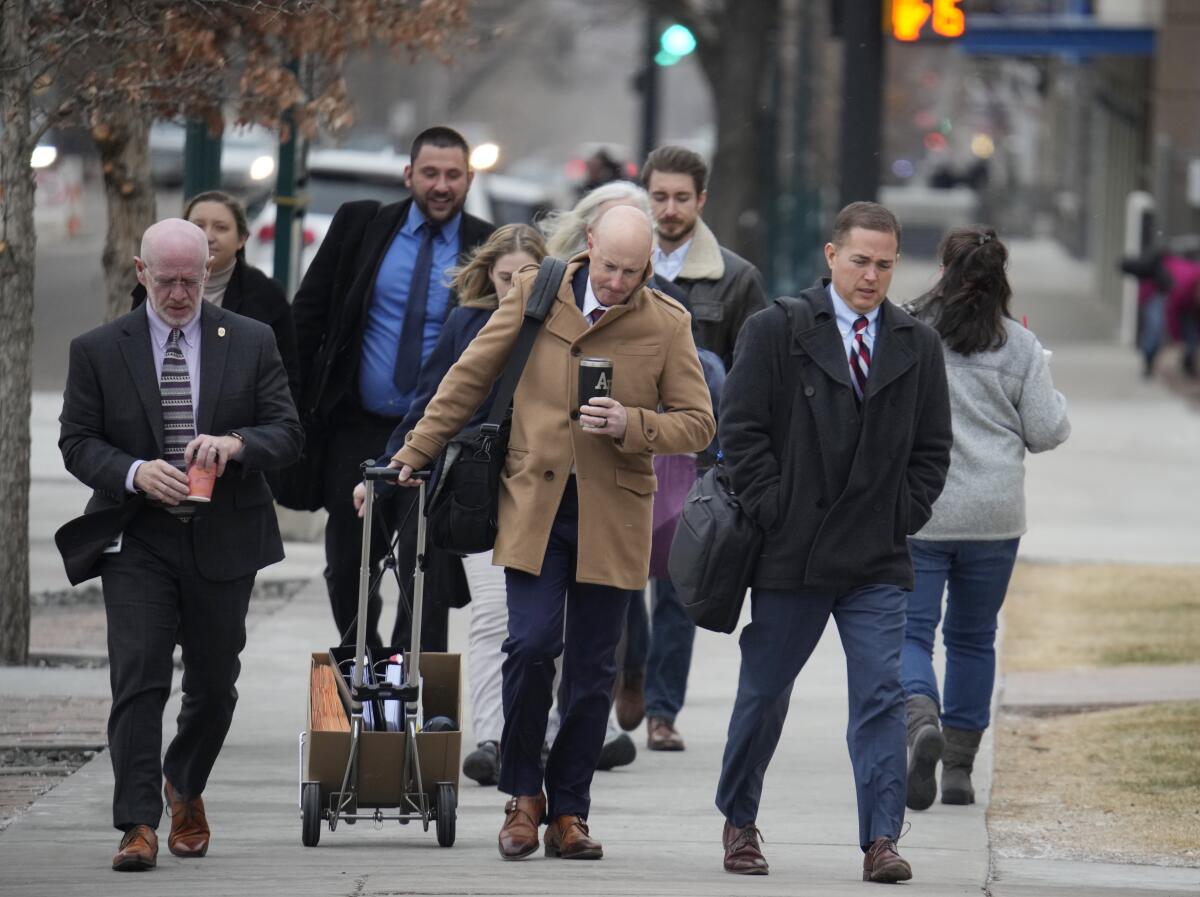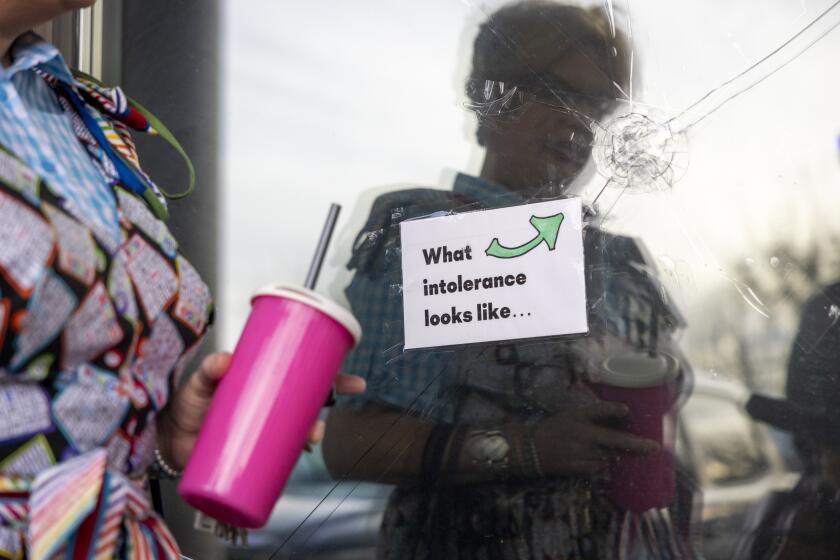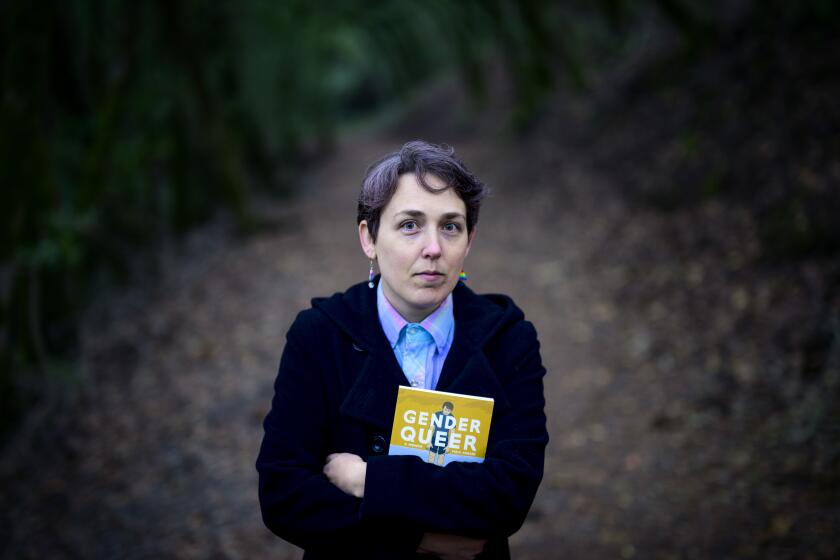Sailor grabbed gun barrel to end Club Q shooting, detective testifies

COLORADO SPRINGS, Colo. — A Navy sailor who was one of two men credited with ending a deadly mass shooting at a gay nightclub in Colorado Springs in November grabbed the barrel of the gunman’s rifle, blistering his hand because it was so hot, a police detective testified Wednesday.
As panicked patrons fled from the dance floor at Club Q, Petty Officer Second Class Thomas James tumbled off a landing with the 22-year-old gunman, Anderson Lee Aldrich. They then struggled over a handgun and Aldrich fired at least once, shooting James in the ribs, Det. Ashton Gardner said at the start of a three-day hearing to determine whether there’s enough evidence to warrant a hate crime charge against Aldrich in the Nov. 19 attack.
After being shot, it is clear from the video that James was tiring, “but he continues to do what he can to subdue the suspect until police arrive,” Gardner testified, noting also that James later gave up his spot in an ambulance to someone else who was injured.
Aldrich, who is nonbinary and uses the pronouns they and them, shook during the testimony about those they shot. Wearing an orange jumpsuit, Aldrich cried while being led out of court for the lunch break.
James, who issued a statement days after the attack saying he “simply wanted to save the family that I found,” didn’t appear to be at Wednesday’s hearing. The other man credited with stopping Aldrich that night, Army veteran Richard Fierro, sat in the back row. His daughter’s boyfriend was killed in the attack.
Drag queens are more mainstream than ever, as are LGBTQ rights. Yet, story hours, where drag queens read to kids, have become a point of controversy and even violence.
After the gunfire ended and police arrived, Aldrich tried to pin the shooting on one of the patrons who subdued them while also claiming that the shooter was hiding, Officer Connor Wallick testified. Officers didn’t believe it and shortly afterward confirmed that Aldrich, 22, was the shooter, he said.
Police found several high-capacity magazines at the scene, including a drum-style one that carries 60 rounds and was empty and others that carry 40 rounds, Gasper said. A state law passed after the 2012 Aurora, Colo., theater shooting bans magazines that carry more than 15 rounds.
Unlike the other charges Aldrich faces, including murder and attempted murder, hate crime charges require prosecutors to present evidence of a motive — that Aldrich was driven by bias, either wholly or in part. That could include statements Aldrich made on social media or to other people, said Karen Steinhauser, a trial lawyer, former prosecutor and current University of Denver law professor who isn’t affiliated with the case.
Coming into the hearing, prosecutors hadn’t revealed anything about why they charged Aldrich with a hate crime.
Although Aldrich identifies as nonbinary, someone who is a member of a protected group such as the LGBTQ+ community can still be charged with a hate crime for targeting peers. Hate crime laws are focused on the victims, not the perpetrator.
Maia Kobabe’s graphic memoir “Gender Queer” became the most banned book in American schools, drawing the Northern California artist and writer into the nation’s cultural wars.
Prosecutors usually win preliminary hearings since the standard of proof is lower than at trial and the evidence must be viewed in a light most favorable to them. But defense lawyers sometimes still want to proceed with preliminary hearings because they offer the chance to question witnesses under oath, including investigators, and to learn more about the government’s case than might be available in the reports that likely have already been turned over to them, Steinhauser said.
The shooting was captured on surveillance video. It showed Aldrich entering the club wearing a red T-shirt and tan ballistic vest while holding an AR-style rifle, with six magazines for the weapon and a pistol visible, said police Det. Jason Gasper. Soon after entering, Aldrich opened fire indiscriminately, authorities have said.
At Aldrich’s apartment, investigators found gun-making materials, receipts for weapons and a drawing of the club. In Aldrich’s mother’s room, they found round gun range targets with holes in them, Gasper said. She had taken him to the gun range.
During cross-examination, Gasper said investigators found “concerning writings.” But he said they didn’t find a manifesto or a plan to target members of the LGBTQ community either on Aldrich or in his home.
The night of the attack wasn’t Aldrich’s first visit to the club. Surveillance video showed them at the bar with a drink on Oct. 29, Gasper said. Aldrich’s attorney also revealed during a recent hearing that Aldrich was at the club earlier on the night of the shooting for about 1½ hours, but he didn’t say why or elaborate.
Questions also remain about how Aldrich got the gun or guns used in the shooting, but experts say how and where Aldrich obtained them doesn’t have to be discussed in order to persuade the judge to rule that there’s enough evidence to take the case to trial.
Conservatives vilify school librarians as “groomers and pedophiles” for stocking LGBTQ and racially themed books. “We have been cursed,” said one librarian.
Questions were raised early on about whether authorities should have sought a red flag order to stop Aldrich from buying guns after Aldrich was arrested in 2021, when they threatened their grandparents and vowed to become the “next mass killer,” according to law enforcement documents.
Authorities said two guns seized from Aldrich in that case — a ghost gun pistol and an MM 15 rifle — weren’t returned. That case was dropped, in part because prosecutors couldn’t track down Aldrich’s grandparents and mother to testify, so Aldrich had no legal restrictions on buying guns.
Former Dist. Atty. George Brauchler, who prosecuted the Aurora theater mass shooting case but who isn’t affiliated with the case against Aldrich, said if Aldrich illegally obtained the gun or guns used in the attack, that would make it harder to plead not guilty by reason of insanity, if that’s what Aldrich chooses to do. Circumventing gun laws would show that Aldrich knew right from wrong, as would showing that Aldrich was motivated by bias, he said.
“Hate isn’t insane. Hate is a choice,” Brauchler said.
Defense attorneys have not publicly raised insanity or Aldrich’s mental health as an issue and they haven’t been asked to enter a plea yet. However, an insanity plea is one of the few options Brauchler said he sees for the defense.
“It’s not a whodunit. It’s not a what happened. It’s a why did it happen,” he said.
More to Read
Sign up for Essential California
The most important California stories and recommendations in your inbox every morning.
You may occasionally receive promotional content from the Los Angeles Times.













